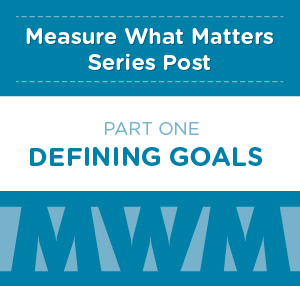Measure What Matters: Defining Goals to Get More From Google Analytics

Measuring activity on your site means more than just counting the number of views. By setting up goals early on, you can gain deep insights into how your customers or visitors interact with your site.
Part one in a series of four, inspired by the book “Measure What Matters: Online Tools For Understanding Customers, Social Media, Engagement, and Key Relationships,” by Katie Delahaye Paine.
So you installed Google Analytics on your website to help you understand what your users are doing when they visit. Google Analytics collected data for a few months, you logged in a few times to take a peek at the reports, but you are still wondering, “What does all this data mean to my business?” If you’re not sure how to answer this question, don’t worry.
Google’s powerful analytics application can help you answer the following important questions:
- How do potential customers engage with my site?
- Are potential customers engaging the way I want?
- What marketing campaigns are performing the best on my site?
- How good is my site at converting visitors into customers?
- What pages on my site drive the most conversions?
In order to refine how you measure performance and determine opportunities for your website, you need take a step back to make sure you have a method to guide your measurements. That’s where defining goals comes in.
How Goals Help Your Business Objectives
Goal conversions are the primary metric for measuring how well your website fulfills your business objectives. Some examples of business objectives are to increase sales, lower costs or build brand awareness. If you run a non-profit business, some sample goals might be to attract more donors, attract more volunteers, or educate the public about a cause.
In Google Analytics, a goal represents an action or engagement with your website that is important to the success of your business. E-commerce sites could have goals for completed transactions or visitors entering the shopping system. Non-e-commerce websites might have goals like downloading a document, completing a contact request form, viewing specific pages, or adding/editing a profile. Once you have set up your goals, you will be able to see conversion rates and the monetary value of the visitors that come to your website.
Three types of goals you can set up in Google Analytics:
Time on Site
A conversion is triggered when a visitor spends more or less time on the site than the threshold you have specified. You should be careful with this measurement, because it can be very difficult to determine the right amount of time that qualifies as a quality visit.
Pages/Visits
A conversion is triggered when a visitor views more pages or fewer pages than the threshold you have specified.
URL Destination
This is the page visitors see once they have completed an activity. For example, a site that requires registration might define this destination as the “Thank You for signing up” page after the user has completed registration. This goal triggers a conversion when a visitor views the page you have specified as the destination.
For all three types of goals you can enter a goal value. Google Analytics uses this assigned goal value to calculate return on investment (ROI) and other revenue related metrics for non-e-commerce sites. Say you know that your sales team typically closes 10 percent of people who request to be contacted. If your average transaction is $500, then you could assign a value of $50 to your “Contact Me” goal.
Additionally, for URL Destination goals you have the option to define a funnel path. Wait, what’s a funnel, you ask?
Stay tuned for part two in this series, where we will describe the powerful ways in which Google Analytics can measure funnel paths on your web site.



